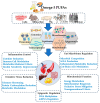Dietary Omega-3 PUFAs in Metabolic Disease Research: A Decade of Omics-Enabled Insights (2014-2024)
- PMID: 40507105
- PMCID: PMC12157617
- DOI: 10.3390/nu17111836
Dietary Omega-3 PUFAs in Metabolic Disease Research: A Decade of Omics-Enabled Insights (2014-2024)
Abstract
Background/Objectives: The rising global prevalence of metabolic diseases (e.g., obesity, type 2 diabetes mellitus) underscores the need for effective interventions. Omega-3 polyunsaturated fatty acids (PUFAs) exhibit therapeutic potential, yet their molecular mechanisms remain unclear. This systematic review synthesizes a decade (2014-2024) of omics research to elucidate Omega-3 PUFA mechanisms in metabolic diseases and identify future directions. Methods: A PRISMA-guided search of the Web of Science identified studies on Omega-3 PUFAs, metabolic diseases, and omics. After excluding reviews, non-English articles, and irrelevant studies, 72 articles were analyzed (16 multi-omics, 17 lipidomics, 10 transcriptomics/metabolomics/microbiomics each, and 6 proteomics). Results: Omics studies demonstrated that Omega-3 PUFAs, particularly EPA and DHA, improve metabolic health through interconnected mechanisms. They regulate epigenetic processes, including DNA methylation and miRNA expression, influencing genes linked to inflammation and insulin sensitivity. Omega-3 PUFAs reduce oxidative stress by mitigating protein carbonylation and enhancing antioxidant defenses. Gut microbiota modulation is evident through increased beneficial taxa (e.g., Bacteroidetes, Akkermansia) and reduced pro-inflammatory species, correlating with improved metabolic parameters. Mitochondrial function is enhanced via upregulated fatty acid oxidation and TCA cycle activity, while anti-inflammatory effects arise from NF-κB pathway suppression and macrophage polarization toward an M2 phenotype. Challenges include interindividual variability in responses and a limited understanding of dynamic metabolic interactions. Conclusions: Omega-3 PUFAs target multiple pathways to improve metabolic health. Future research should prioritize chemoproteomics for direct target identification, multi-omics integration, and personalized strategies combining Omega-3 with therapies like calorie restriction.
Keywords: metabolic diseases; omega-3 polyunsaturated fatty acids; omics.
Conflict of interest statement
Author T. Z. was employed by the company Better Way (Shanghai) Cosmetics Co., Ltd. The remaining authors declare that the research was conducted in the absence of any commercial or financial relationships that could be construed as a potential conflict of interest.
Figures





Similar articles
-
Interaction between dietary omega-3 polyunsaturated fatty acids, obesity and gut microbiota in preclinical models: A systematic review of randomized controlled trials.Diabetes Obes Metab. 2025 Sep;27(9):4643-4661. doi: 10.1111/dom.16535. Epub 2025 Jun 19. Diabetes Obes Metab. 2025. PMID: 40536121 Review.
-
Gut Microbiota-Targeted Therapeutics for Metabolic Disorders: Mechanistic Insights into the Synergy of Probiotic-Fermented Herbal Bioactives.Int J Mol Sci. 2025 Jun 7;26(12):5486. doi: 10.3390/ijms26125486. Int J Mol Sci. 2025. PMID: 40564947 Free PMC article. Review.
-
Anti-arthritic effects of polyunsaturated fatty acid-rich supplementation combined with selective soluble epoxide hydrolase inhibitors in a collagen-induced arthritis mouse model.Mod Rheumatol. 2025 Jul 5;35(4):665-676. doi: 10.1093/mr/roaf019. Mod Rheumatol. 2025. PMID: 40048675
-
Saturated Fatty Acids and Omega-3 Polyunsaturated Fatty Acids Improve Metabolic Parameters in Ovariectomized Female Mice.Endocrinology. 2023 Apr 17;164(6):bqad059. doi: 10.1210/endocr/bqad059. Endocrinology. 2023. PMID: 37029960 Free PMC article.
-
Omega-3 polyunsaturated fatty acids and Parkinson's disease: A systematic review of animal studies.J Neurochem. 2024 Aug;168(8):1655-1683. doi: 10.1111/jnc.16154. Epub 2024 Jun 24. J Neurochem. 2024. PMID: 38923542
References
-
- Cousin E., Duncan B.B., Stein C., Ong K.L., Vos T., Abbafati C., Abbasi-Kangevari M., Abdelmasseh M., Abdoli A., Abd-Rabu R., et al. Diabetes mortality and trends before 25 years of age: An analysis of the Global Burden of Disease Study 2019. Lancet Diabetes Endocrinol. 2022;10:177–192. doi: 10.1016/S2213-8587(21)00349-1. - DOI - PMC - PubMed
Publication types
MeSH terms
Substances
Grants and funding
- JCYJ20220530143615035/Shenzhen Science and Technology Program
- LGKCSDPT2024001/Warshel Institute for Computational Biology funding from Shenzhen City and Longgang District
- HZQB-KCZYB-2020056, P2-2022-HDH-001-A/Shenzhen-Hong Kong Cooperation Zone for Technology and Innovation
- 2022E0035/Guangdong Young Scholar Development Fund of Shenzhen Ganghong Group Co., Ltd.
- 2023E0012/Phase III Government Matching Fund of Shenzhen Ganghong Group Co., Ltd.
- 2024A0505050001, 2024A0505050002/Guangdong S&T programme
- HUUF-MS-202306, HUUF-MS-202308, HUUF-MS-202309/2023 The Second Affiliated Hospital of the Chinese University of Hong Kong, Shenzhen Joint Fund Project
- 2024E0049/CUHK(SZ) HOMEY HEALTH Micro-biome and EndoMetabolic Digital Health Research Center
LinkOut - more resources
Full Text Sources
Medical
Research Materials

